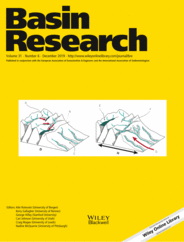
Full text loading...
Deformation, isostasy and erosion for one 8 km increment of thrust motion (479 km total). Top panel, fault displacement and isostatic loading following 8 km of displacement. Middle panel, new estimated topography and erosion. Bottom panel, estimated cross section geometry and topography following erosion and deposition.
Forward modeled, balanced cross sections that account for the flexural response to thrust loading and erosional unloading can verify and refine the kinematic sequence of deformation in fold‐thrust belts as well as help assess the validity of a balanced cross section. Results from flexural‐kinematic reconstructions that indicate either the cross section, the kinematic order or both are invalid include: (a) a predicted final topography that is dramatically different from the actual topography; (b) large normal fault or thrust fault bounded synorogenic basins that are not present in the mapped geology; and/or (c) an exhumation history that is not consistent with provenance records in the basin or measured thermochronometers. Where detailed measured foreland basin sections exist, flexural‐kinematic modeling of fold‐thrust belt deformation, including out‐of‐sequence (OOS) faults can predict a foreland basin evolution that can be compared to measured data. The modeling process creates a “pseudostratigraphy” in the modeled foreland. The pseudostratigraphy and predicted provenance of each modeled stratigraphic increment can be directly compared to measured stratigraphic sections. We present a case study using two cross sections through the Himalaya of far western Nepal (Api and Simikot) to assess the validity of the section geometries and the resulting kinematic histories, displacement rates, flexural wave response and predicted provenance for both sections. Insights from combining the flexural‐kinematic models with existing stratigraphic data include: (a) Changing the order of proposed OOS and normal faults to earlier in the evolution of the fold‐thrust belt was necessary to reproduce the foreland provenance data. We argue that OOS thrust and normal faults in the Api section occurred between 11 and 4 Ma. (b) Published shortening estimates for the Simikot cross section are too high (>50 km), resulting in unrealistic shortening rates up to 80 mm/yr between 25 and 20 Ma. (c) Flexural forward models with and without an additional sediment loading modeling step indicate that while sediment loading does not have a measurable effect on the magnitude and location of erosion within the fold‐thrust belt, it does have a small effect on accumulation rates and thus the predicted age of stratigraphic boundaries when compared to measured stratigraphic thicknesses and age. Thickness difference range from 0.2 to 0.5 km and can result in predicted age differences of ca. 1 Ma. Accounting for both flexural isostacy and erosion can eliminate unviable kinematic sequences and when combined with provenance data from measured stratigraphic sections, can provide insight into the order, age and rate of deformation.
]
Article metrics loading...

Full text loading...
References


Data & Media loading...

